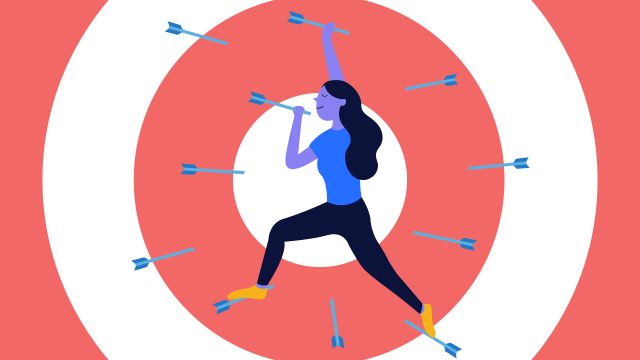We have a finite amount of time. However, in the course of a lifetime, the average person will spend 13 years and two months at work. If we’re going to spend that much time doing something, it’s in our best interest to do it to the best of our ability.
This article covers 36 ways to improve your work performance and a handy do’s & don’ts list you can refer back to in order to refresh your memory. Skip right to the infographic here!
36 Ways To Improve Work Performance:
- Run Effective Meetings
- Apply The 80/20 Rule
- Overcome Resistance To The Hard To Start Tasks
- Fix Your Bottlenecks
- Continue To Learn
- Touch Something Once
- Get Feedback Often
- Learn To Say No
- Surround Yourself With Productive People
- Automate Whatever You Can
- Practice Email Etiquette
- Manage Distractions
- Set Up Your Workspace For Optimal Productivity
- Set Self-imposed Deadlines
- Group Similar Tasks Together
- Take Breaks
- Work While You’re At Work
- Check In With Yourself
- Don’t Multitask
- Plan Your Schedule Ahead Of Time
- Know What You Were Hired To Do
- Track How Much Time You Spend On Tasks
- Two-minute Rule
- Take Advantage Of Your Commute
- Give Up On The Illusion Of Perfection
- Listen To Music
- Love What You Do
- Find Out What Your Productive Hours Are
- Keep Track Of Your Personal Developments And Achievements
- Take Care Of Your Health
- Reward Yourself
- Keep Up The Speed Of Your Computer
- Create Systems
- Use Software To Augment Productivity
- Support Productive Practices In The Workplace
- Hold Progress Meetings
1) Run Effective Meetings
Meetings are an inevitable part of our work life, for better or for worse. Learning how to make meetings effective will free up valuable time and attention bandwidth for tasks that are more important to your bottom line.
First, evaluate whether a meeting is necessary at all. Can you communicate over email or over the phone without diluting your message? One of the top productivity tips from CEOs includes saying no to meetings that lack a defined agenda.
If you do need to have a meeting, keep it efficient by setting an agenda, adhering to a time limit, turning meetings into notes with transcription software, or making it a standing meeting.
Summary:
- Call or email instead (when possible)
- Have an agenda
- Make it a standing meeting
- Set a time limit
2) Apply The 80/20 Rule
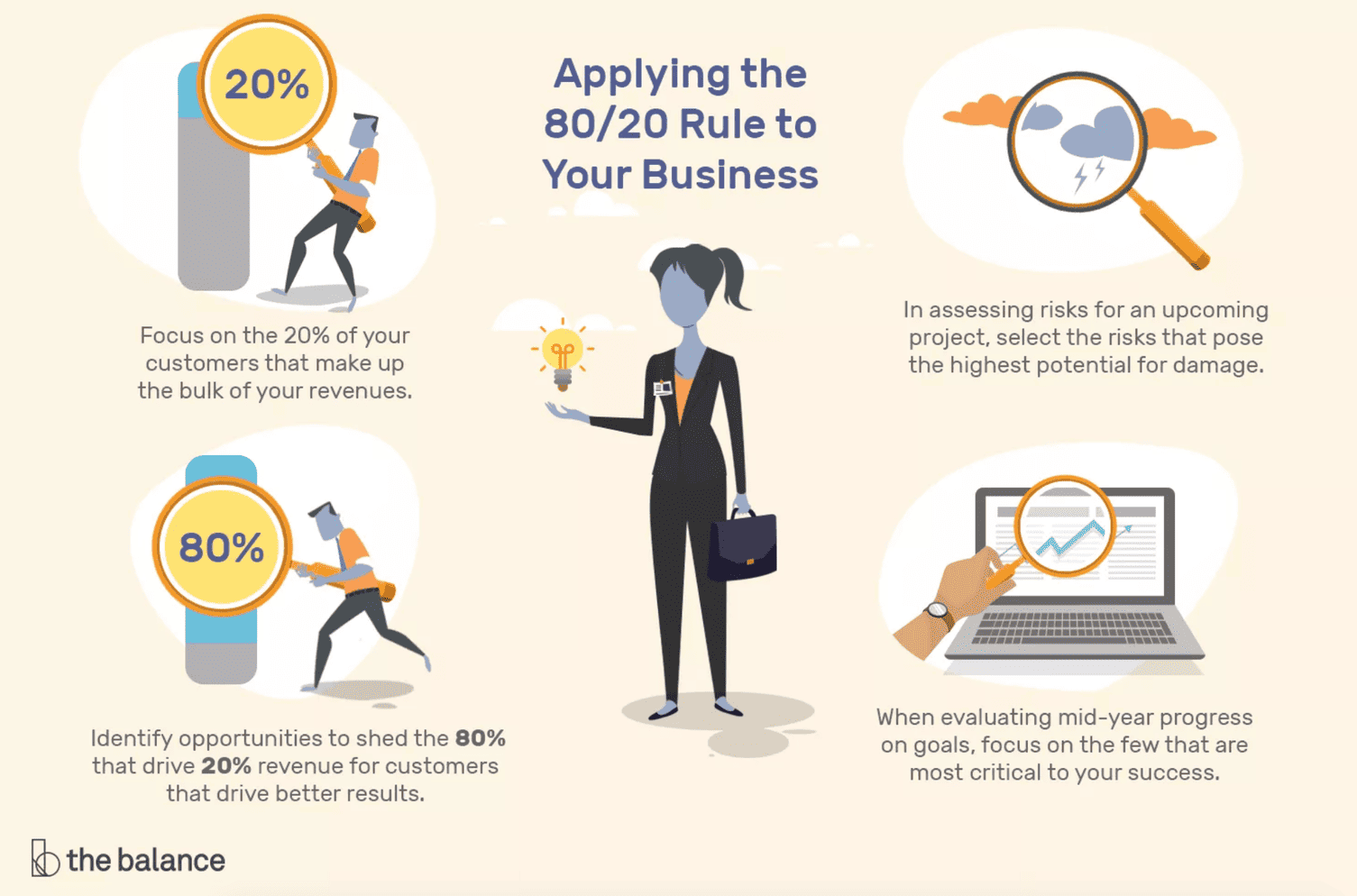
The Pareto principle, or the 80/20 rule, states that 20 percent of our efforts produce 80 of our results. This means that, on average, 80 percent of your efforts are spent on producing things that don’t matter as much to your personal bottom line.
Summary: Prioritize your day so you work toward your main goal first
3) Overcome Resistance To The Hard To Start Tasks
How many times have you put off a hard-to-start task only to find out that it wasn’t as difficult to do once you started?
If your answer is ‘more than you’d like to admit’, then you’re not alone!
Tackle the hardest tasks first
Kris Hughes, Senior Content Manager at ProjectManager.com, suggests eating the frog first thing in the morning.
He says, “If you always tackle your most dreaded or most difficult task first thing in the morning, the remainder of the tasks you have to do throughout the day will pale in comparison, and you’ll be able to maintain a high level of productivity throughout, rather than dreading the frog as the clock ticks.”
Tackling daunting tasks earlier in the day means that you’ll have a clearer mind than you would have after a day’s worth of work.
Bite-sized tasks are better on the nerves
Hughes also suggests breaking daunting tasks into manageable, bite-sized pieces. Not only will the task seem less daunting, but getting things done, however incremental they might be in relation to the bigger goal, will give you the momentum to get more done.
Summary: Break down daunting tasks into smaller tasks and start working on them first thing in the morning.
4) Fix Your Bottlenecks
Identify what slows you down or the business down, and figure out ways to improve it. This article offers ways to identify bottlenecks and how to unblock them.
For example, if you’re on the road a lot but still need connectivity, identify a solid VoIP app you could use.
Summary: Figure out what slows you down and improve or put a stop to it.
5) Continue To Learn
This can be as big or small an undertaking as you’d like. Keeping ahead of trends in your industry or even learning keyboard shortcuts are low-effort ways of improving your work performance.
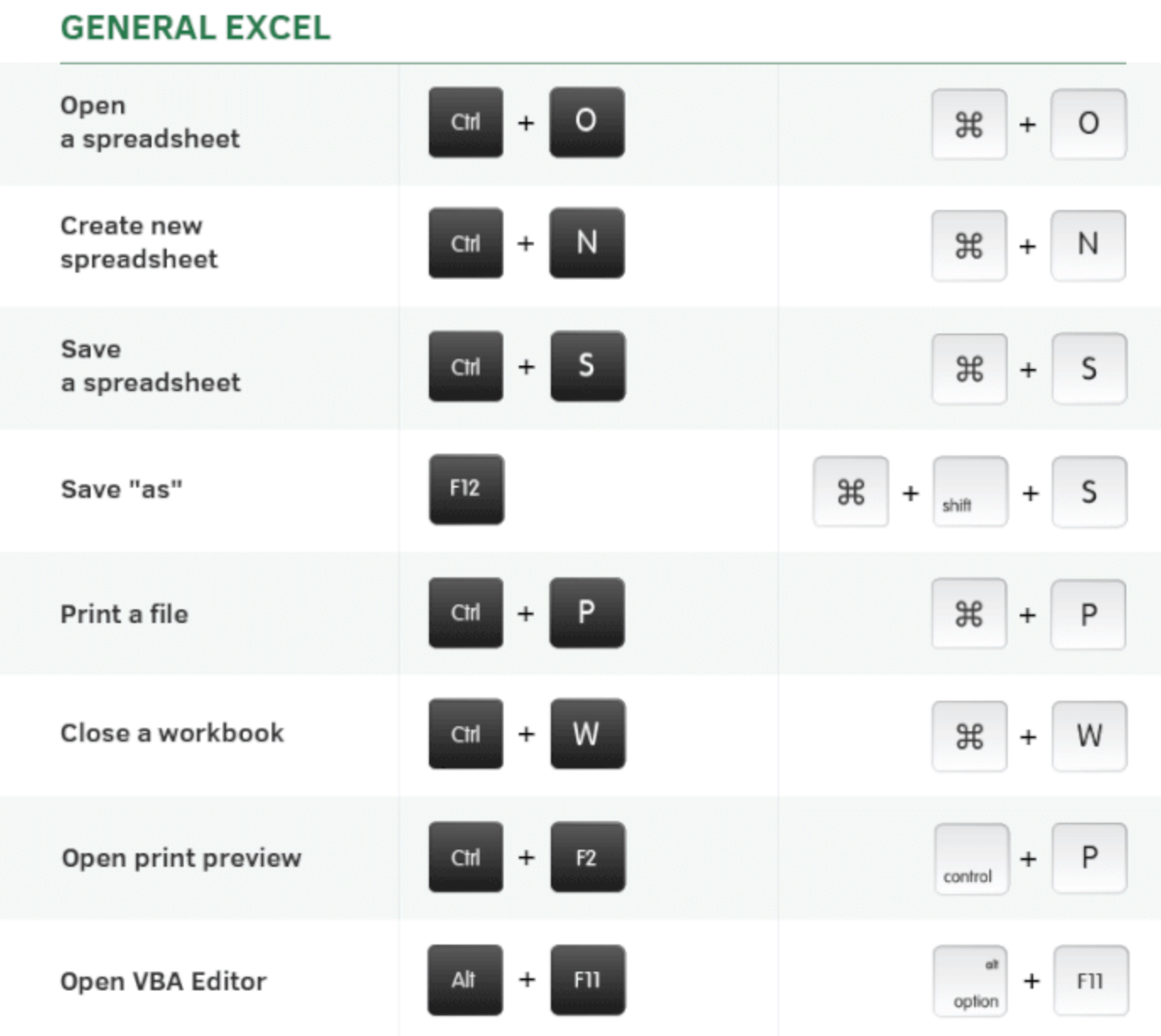
However, if you’re willing to put in more time, consider taking an online course.
There are plenty of skills that can help you improve your performance at work, like project management or soft skills.
Summary: Determine how much time you can devote, and make a daily or weekly habit out of learning
6) Touch Something Once
Don’t start working on something unless you have the ability to follow through with the next steps. Doing this will avoid instances where you repeatedly look at paperwork or an email but push it aside for a later date.
Adhering to the “touch it once” rule ensures that this form of procrastination doesn’t happen and reduces the amount of “unfinished business” you have.
Summary: Finish what you start in one go (when possible)
7) Get Feedback Often
Don’t wait until your quarterly- or annual review to get feedback. Ask for it often so you don’t miss out on opportunities for growth and development.
For example, here’s an employee feedback template from SurveyMonkey:
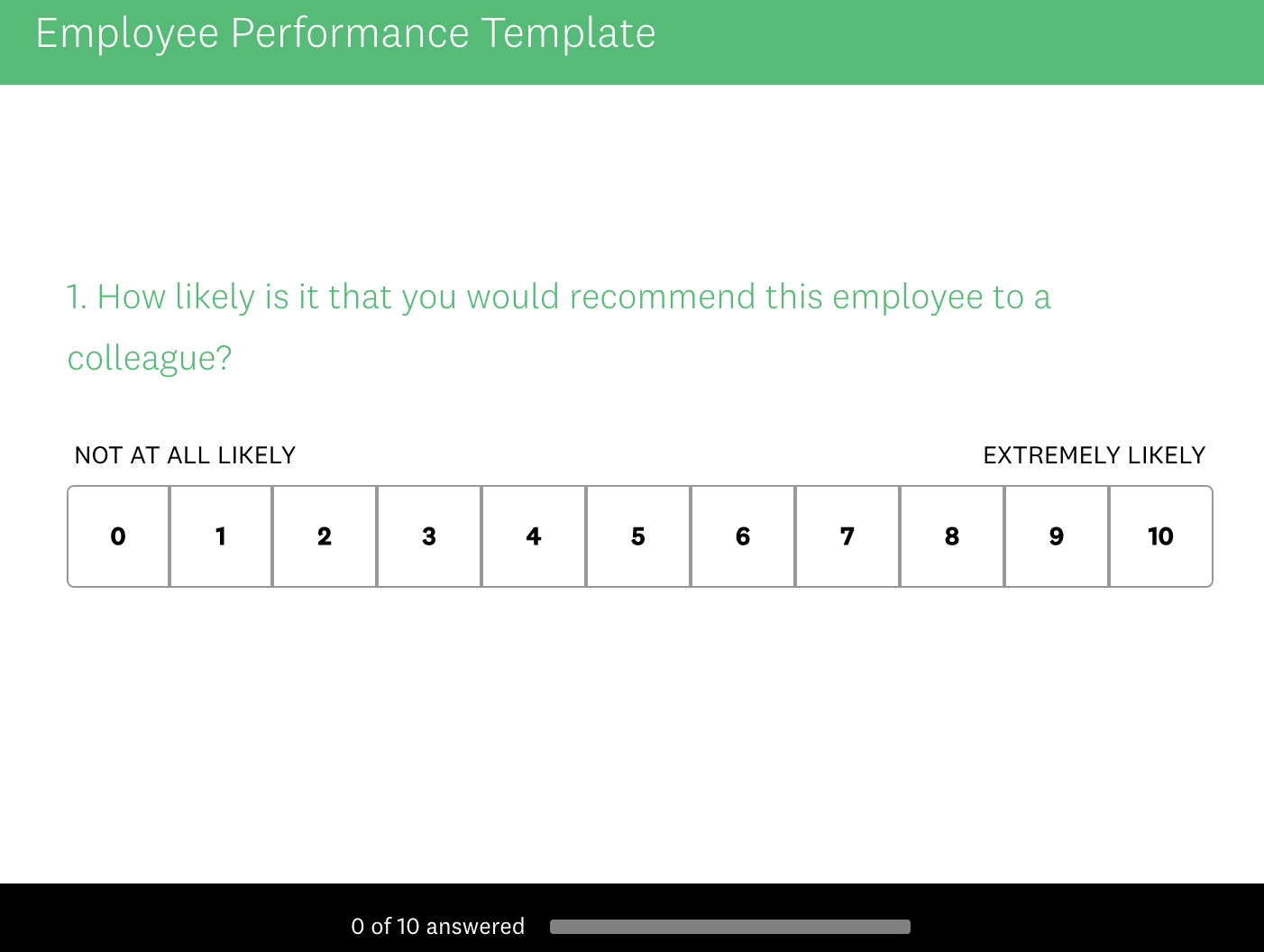
Summary: Have regular check-ins so you don’t miss out on constructive feedback
8) Learn To Say No
When possible, say ‘no’ to the things that aren’t part of your core 20%. We have a limited bandwidth, so when you say ‘yes’ to something unimportant, you could be saying ‘no’ to something that matters more.
Summary: Say ‘no’ to the tasks that don’t matter (when possible).
9) Surround Yourself With Productive People
You’re the average of the five people you spend the most time with. So, if your goal is to be more productive or a better leader, surround yourself with people with those traits.
Summary: Spend time with productive people
10) Automate Whatever You Can
Use automation to make your life a little easier for you. Forrest Bryant, Editorial Director at Evernote, uses automation in three ways:
Proofread work in real-time
Grammarly and After the Deadline browser extensions automatically correct mistakes like contextual spelling errors, incorrect grammar, or poor vocabulary usage.
For more complex proofreading, the Hemingway App identifies long, complex sentences, weak phrases, passive voice, and more.
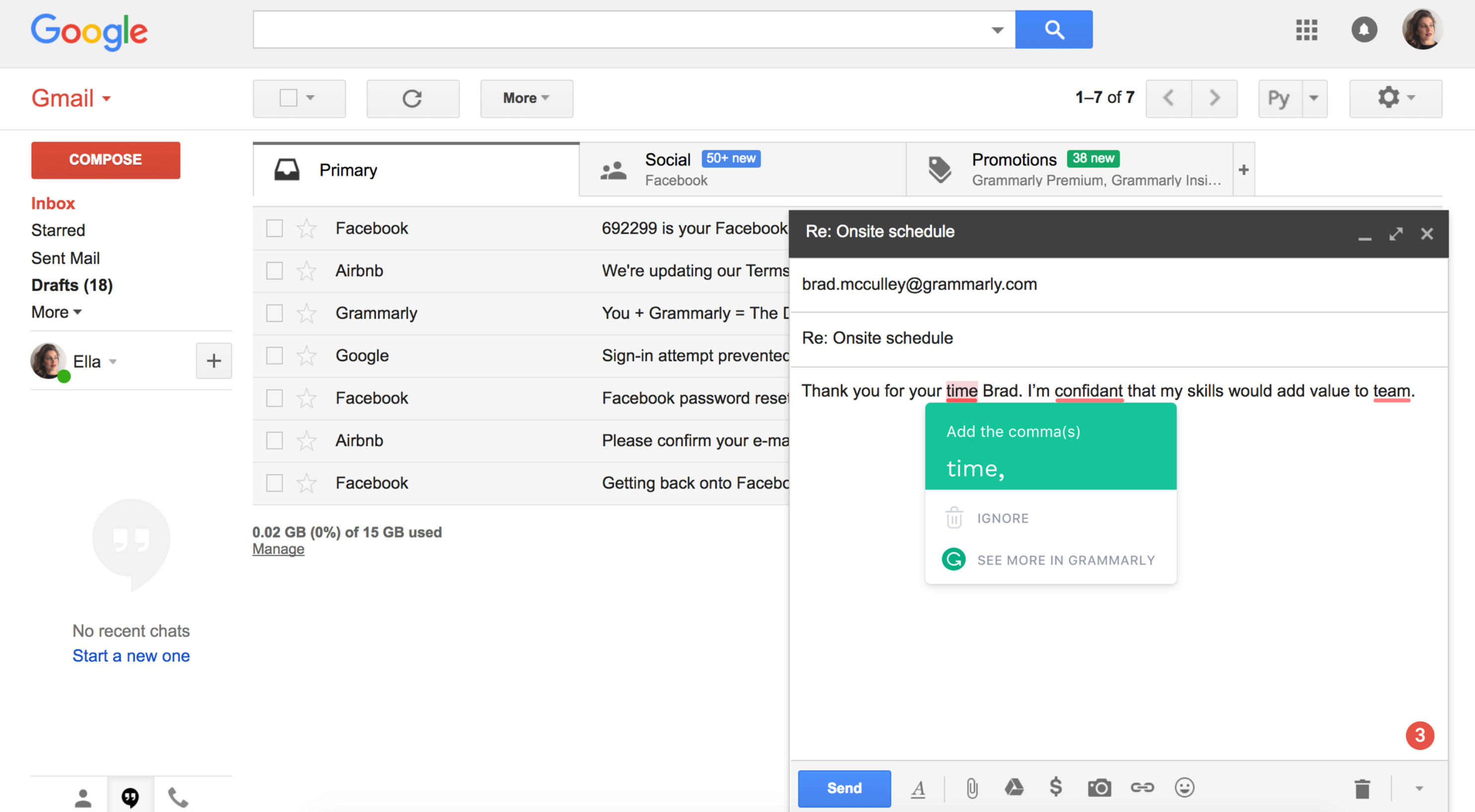
Let templates do the prep work for you
With professionally designed templates available directly through the Evernote app, you can create great notes quickly without having to start from scratch, figuring out formatting and layouts.
Just click the Template button when creating a new note, and you can instantly choose from your personal collection of templates.
Leverage AI to schedule meetings for you
You don’t need to wait until you get to the corner office to have an executive assistant. AI assistants Amy and Andrew, created by x.ai, schedule all your meetings for you, saving you the endless back-and-forth that easily drains hours each day.
There’s nothing to download — simply CC Amy in an email, and she will look at your calendar, email your guest, and send a meeting invite to both of you.
Summary: Automate what you can to free up time for tasks only you can do
11) Practice Email Etiquette
When the content of email changes, so should the subject line. Avoid using vague subject lines where possible because it will be a pain for you and your recipient(s) to find.
Keep emails short and to the point. If your email needs more than a couple of sentences, than another form of communication (e.g., a call or meeting) may be more appropriate.
Summary: Keep emails short and subject lines clear
12) Manage Distractions
Our attention spans are finite. Keep distractions to a minimum by turning off notifications (or turning off your phone entirely), stopping “got a minute” meetings, scheduling time to check emails and make phone calls, and wearing headphones.
If you’re easily distracted, try arriving earlier so you can get work done with minimal interruption.
Stacy Caprio, Founder of Accelerated Growth Marketing, recommends creating a time-block of distraction-free work that includes “no email, phone or social media, and has to be focused on your most important tasks.”
Minimize digital distractions by turning off notifications and setting boundaries.
13) Set Up Your Workspace For Optimal Productivity
Where you work can make a difference to your level of productivity. Research shows that having plants in the office boosted productivity by up to 15 percent and increased workplace satisfaction.
Keep a clean desk and take out only what you need for the task at hand. You will spend less time looking for what you need and won’t have to look at a cluttered desk.
Eileen Roth, the author of Organizing for Dummies, suggests putting away food so people are less likely to come around your desk to chat while they snack.
Summary: Keep your workspace organized and clean. If possible, keep a plant or two on your desk.
14) Set Self-imposed Deadlines
You’ve probably heard of Parkinson’s Law – “work expands to fill the time available for its completion.” Use this law to your advantage by setting yourself personal deadlines, even if your work isn’t time-sensitive.
Bobby Gaffin, Account Manager from GMR Web Team, recommends doing this “especially when you’re given open-ended projects, [as] having self-imposed deadlines establishes a more structured and self-motivated working mindset.”
Summary: Set personal deadlines, especially for open-ended projects
15) Group Similar Tasks Together
Take solo-tasking to the next level by grouping similar tasks together. This way, you can further reduce the mental fatigue that comes with task-switching.
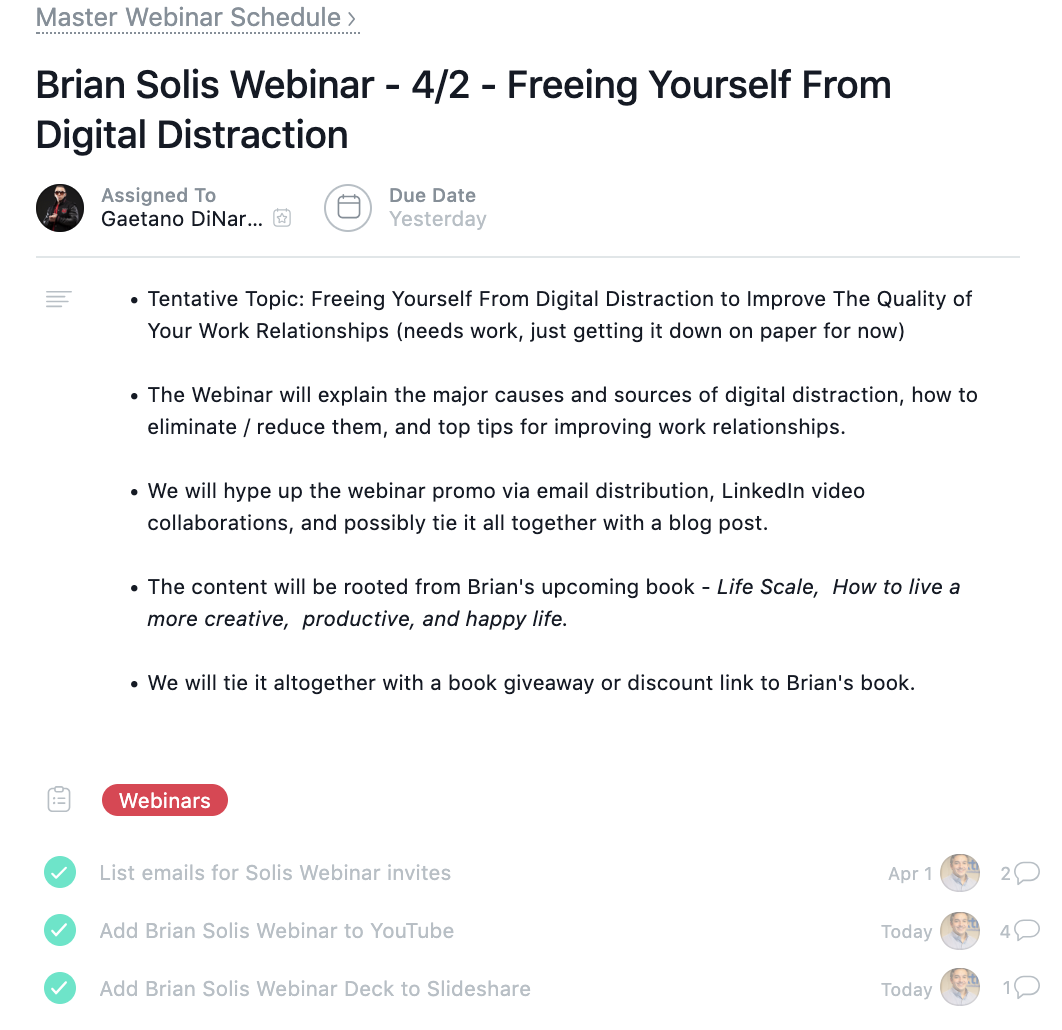
If you’re working on multiple projects, but have to sign off on reports, do them all at once. If you’re writing an article, write out the outlines for both at the same time.
Summary: Group similar tasks together to get things done faster
Related: 5 Proven Digital Marketing Tips to Scale Results
16) Take Breaks
This is arguably the most important tip on this list. No one can be 100 percent productive 100 percent of the time, and attempting to do so will eventually burn you out.
Studies have shown that taking regular breaks makes you more productive. Researchers from the Draugiem Group studied its most productive employees and found that they stepped away from their computers 17 minutes at a time when taking a break.
They concluded that it was most effective to work for 52 minutes at a time, and then take an extended offline break, like chatting with a coworker or going for a walk.
When you’re working in shorter spurts
If you prefer working in shorter spurts, consider the Pomodoro Technique. It’s a system where you hyperfocus on work for 25 minutes and then take a 5-minute break. Each cycle is called a Pomodoro. With every 4 Pomodoros, you can extend a break to 20 or 30 minutes.
Josh Spiker, content manager at ClickUp, recommends setting a reminder and timing your breaks if necessary.
You can use an app like Breaktaker to remind you to move around.
Summary: Take breaks often. Set a reminder and time yourself if you need to. Use those breaks to do something offline (like meditating, walking, or chatting with a coworker.)
17) Work While You’re At Work
The subheading says it all.
Avoid idle conversation (unless you’re on a break) or checking social media and the news (unless that is part of your job). Get into the habit of starting work as soon as you sit (or stand) at your desk.
Summary: Get your work done while you’re at work
18) Check-In With Yourself
Periodically check-in to see if you’re actually working towards your goals. It can be easy to get caught up in the day-to-day, so set a weekly or daily reminder to evaluate whether you’re focusing on your core 20 percent.
If you find that you’re not working on the important things, do your best to delegate, delay, diminish, or eliminate these tasks.
Summary: Set a weekly or daily reminder to realign yourself with your goals
19) Don’t Multitask
There’s a reason solo-tasking is the new productivity buzzword. Studies show that multitasking can reduce productivity by as much as 40 percent.
This is because most of us can’t multitask effectively. We’re just quickly switching tasks, and that can take a mental toll on us, thereby getting less done.
Summary: Work on one thing at a time
20) Plan Your Schedule Ahead Of Time
Prioritize tasks you need to get done daily and weekly to avoid getting caught up with tasks that don’t matter. Aim to do this at the end of the workday while everything is still top-of-mind, so you can hit the ground running the next morning.
Robin Schwartz, Director of Career Igniter, recommends keeping a “to-do” list “to help you fill in the gaps of your day.”
You can schedule your day into time blocks to take your planning up a notch. Kris Hughes, Senior Content Marketing Manager at ProjectManager.com, breaks down the typical nine-hour workday into 30-minute increments.
He says that “being able to check off the 30-minute blocks is a great feeling of accomplishment and a concrete way to see what’s getting done.” He even plans out his breaks and lunch, so he’s not just “grinding.”
Summary: Plan out your day in advance to make the most of your time
21) Know What You Were Hired To Do
After months or years of working in a role, it can be easy to lose focus on what you were hired to do. Speak to your manager about what your objectives and day-to-day should look like and prioritize accordingly.
Make a list of what matters the most so when you plan out your day, you can refer to it.
Also, make sure you own a clear metric or number. This way, it’s your sole responsibility to measure and track that number.
It also comes in handy when you want to ask for a raise. See the post below from Gaetano DiNardi:
Summary: Know what you were hired to do and build those tasks into your day
22) Track How Much Time You Spend On Tasks
“You can only improve something if you measure it” is a popular adage in business. So why shouldn’t it apply to productivity?
Track how your day is spent, either manually by time blocking or digitally with apps like RescueTime.
Doing this will make you more mindful of how you spend your time, and you may also notice patterns in how you work. For example, if you spend too much time on a task that doesn’t advance your 20 percent, then outsource it.
Summary: Track how you spend your time so you can optimize your day accordingly
23) Two-minute Rule
The two-minute rule states that you must immediately do any task or action that can be completed in two minutes or less. This rule is best used to push through any inertia you have when starting a task or project.
Summary: If it can be done in two minutes, do it now.
24) Take Advantage Of Your Commute
You can do several things to improve your work performance even before you get to work.
If you get to work by bus or train, you can read, watch videos, or plan your day out in advance (if you haven’t already done so the night before.) If you drive to work, consider listening to a podcast or audiobook.
Summary: Use your spare time on your commute to upskill or plan your day
25) Give Up On The Illusion Of Perfection
G.K. Chesterton, a philosopher, once said, “Anything worth doing is worth doing badly”.
It’s counter-intuitive but a good way to approach important tasks. If we wait until we feel we can do something perfectly, we might be waiting around for a long time. It’s much better to go into a task or project, knowing that it may be imperfect, but give it our best shot.
Summary: Strive toward excellence, but don’t fear failure.
26) Listen To Music
According to research published by the University of Illinois, moderate level or ambient noise enhances creativity by prompting abstract thinking.
Max Razbo, a web designer, recommends using Defonic for nature-centered ambient noise or Hipstersound to experience the sounds of a coffee shop from wherever you’re working from.
In this study, listening to binaural beats improved the working memory capacity in the participants studied.
Summary: Create your work playlist and jam to that while you work
27) Love What You Do
People who love what they do are happier to get more done.
If you’re not excited by what you do, it might be a good idea to rethink what you do. As mentioned earlier, in the course of a lifetime, the average person will spend 13 years and two months at work. That’s a lot of time to spend doing what doesn’t excite you.
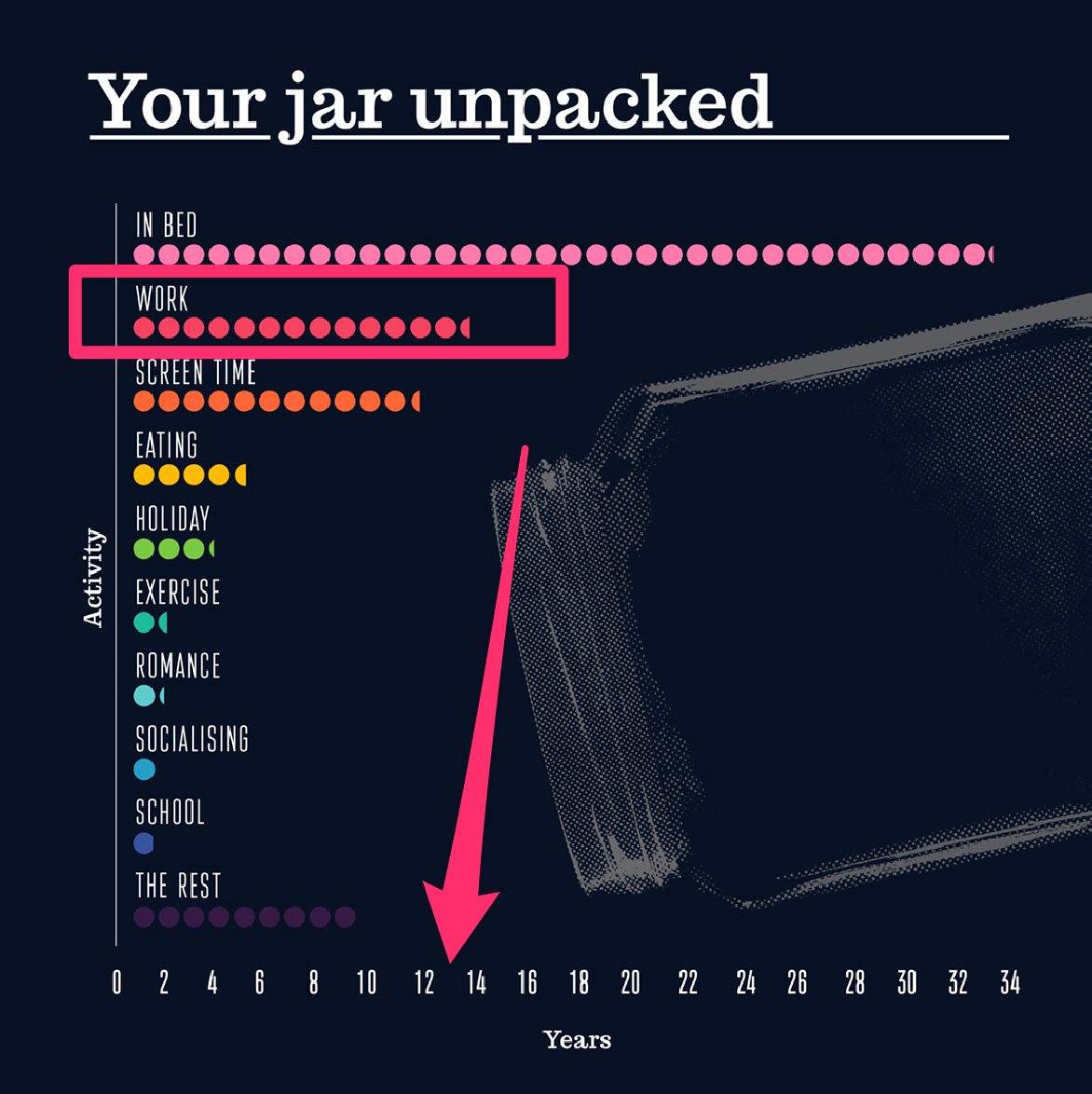
Summary: If you don’t love what you do, find out what you do love, and do that!
28) Find Out What Your Productive Hours Are
Our energy and attention levels spike and decline throughout the day. Generally, our focus peaks before lunch, and our creativity spikes when we’re most fatigued.
However, each person is different.
Once you find out when you’re most productive, start scheduling your day around these hours. For example, if you’re more adept at doing cognitively-intense tasks in the afternoon, try to avoid scheduling meetings around that time.
Summary: Plan your schedule around your most productive hours
29) Keep Track Of Your Personal Developments And Achievements
At the end of each week, note down three things you achieved that week and three things you could do better the following week. Tracking your achievements is an excellent way of motivating yourself to do more.
Having a list like this is handy, especially if you plan on asking for a raise or job hunting.
Summary: Keep a log of your achievements and goals
30) Take Care Of Your Health
Our bodies are like engines. If they don’t have the proper fuel and maintenance, they won’t be able to perform to their best ability.
Don’t skimp on sleep
Get a minimum of seven hours of sleep, and make sure you’re practicing good sleep hygiene (e.g., no electronics or blue light before bed, sleep, and wake up at regular times each day).
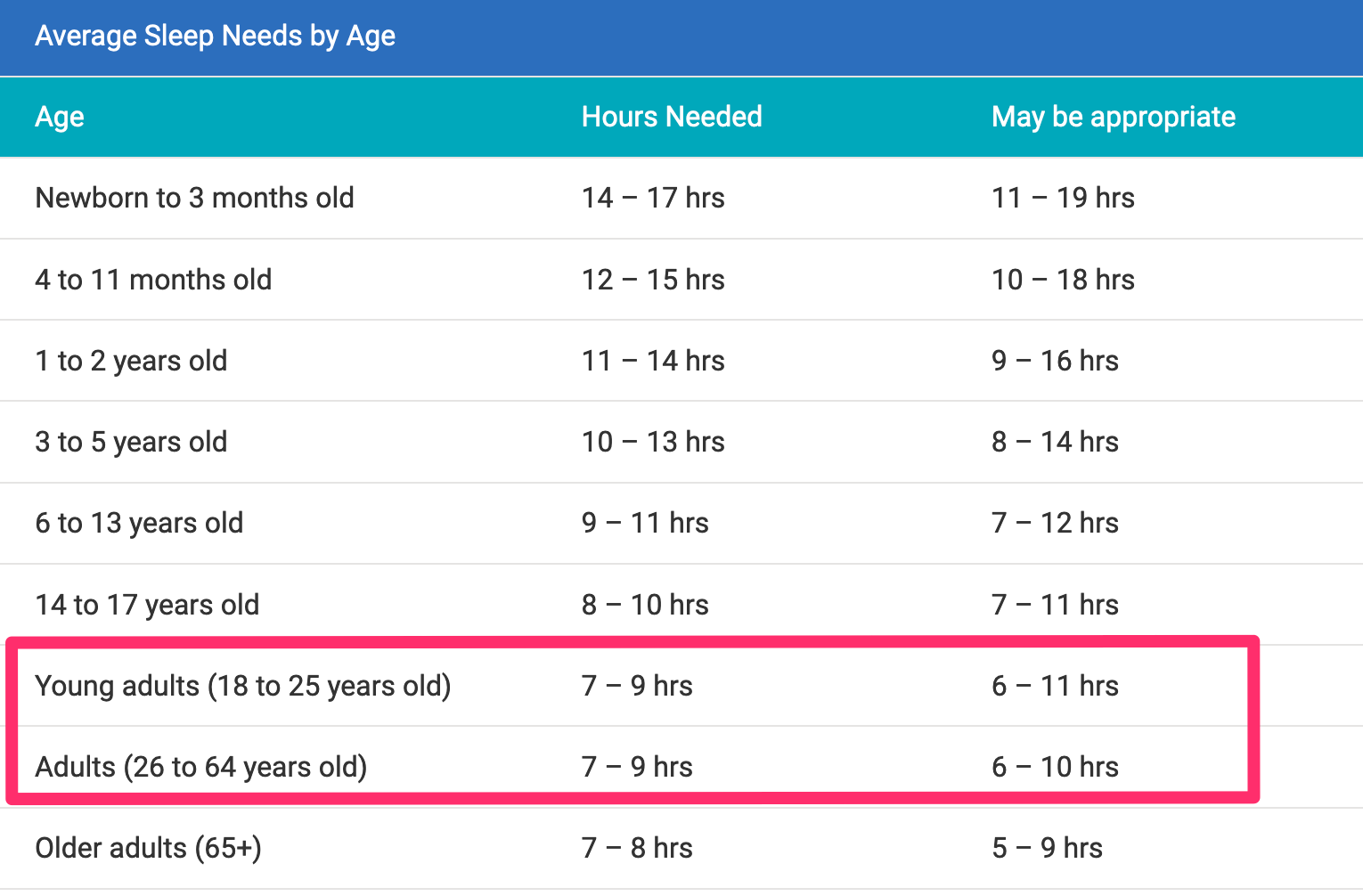
Stay hydrated
Keep a bottle of water at your desk and stay hydrated. If you feel like you’re getting brain fog, it’s probably because you haven’t had enough to drink. Eat a balanced diet and avoid keeping unhealthy snacks on your table.
Be on the move
Finally, stay active. Stretching, walking, and yoga can do wonders for the stiffness that comes with sitting at a desk for eight hours.
https://www.youtube.com/watch?v=tAUf7aajBWE
Summary: Get enough sleep, stay hydrated and well-fed, and get moving.
31) Reward Yourself
Reward yourself when you finish a project or hit a milestone. This can be anything from chatting with a coworker or buying yourself a treat. Having ‘carrots’ to work towards makes work a little more fun.
Summary: Reward yourself for hitting milestones.
32) Keep Up The Speed Of Your Computer
Don’t let your computer slow you down. Periodically clean up files, sweep the hard drive, and update software.
If you mostly work remotely, it may help to read up on tips to maximize working from home.
Summary: Maintain the speed of your computer so it doesn’t slow you down.
33) Create Systems
Create systems to do the heavy lifting of thinking for you. David Alexander, Digital Marketer at Mazepress, recommends “systematizing the recurring processes in your business with tools like checklists, calendars, and other project management tools.”
He adds that “even a simple checklist you can refer back to makes a massive difference in how long it takes to repeat a process.”
Summary: Use checklists or create systems to simplify your day-to-day
BONUS: How Do You Increase Employee Productivity?
As a manager, there are a number of things you can do to improve work performance. Some of the pointers on the list above are things both you and your team can do together, like:
- Running effective meetings
- Fixing bottlenecks
- Setting up the workplace for productivity
- Creating systems
The points below are things that can boost productivity from the top down.
34) Use Software To Augment Productivity
When used correctly, the right software can really make a difference in the workplace. Depending on the size and function of your team, it may be valuable to look into a communication suite like Nextiva.
There are plenty of tools out there. When selecting one for your team, make a list of the features you need the most (e.g., Kanban board, chat feature, calendar, etc.) and pick one accordingly.
For office productivity, there are plenty of apps and browser plugins that can do anything from fine-tuning the way you use email and eliminate distractions.
If you’re in sales, a platform like Ambition can increase productivity and effectiveness with features like automated sales coaching, flexible sales scorecards, and highly motivating sales contests.
35) Support Productive Practices In The Workplace
Create an environment where your team feels comfortable trying out different ways of being productive. Here are some ways you can do this:
- Implementing flexible or remote work policies
- Allowing plants on desks
- Encouraging breaks
- Providing opportunities to upskill
- Be encouraging
Creating a happy working environment has its own intrinsic benefit, but it’s also proven to boost productivity and workplace satisfaction.
36) Hold Progress Meetings
Instead of waiting for an annual review, schedule meetings with your team members more frequently.
This helps establish a better line of communication where you can set achievable goals, discuss any hurdles, and give each other constructive feedback. Not only does this help your team stay aligned, but you can also get feedback on ways you can be a better manager.
Related: How Do CEOs Organize Their Day? These 10 Chief Executives Reveal Their Routines
Related: INFOGRAPHIC: 10 VoIP Myths & Misconceptions Debunked


